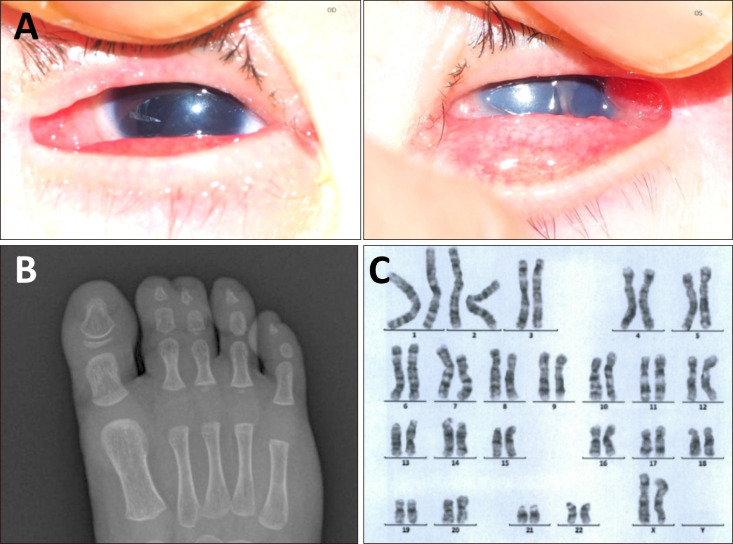Ann Dermatol.
2019 Oct;31(5):576-580. 10.5021/ad.2019.31.5.576.
Hypomelanosis of Ito with Multiple Congenital Anomalies
- Affiliations
-
- 1Department of Dermatology, Seoul National University College of Medicine, Seoul, Korea. kyuhkim@snu.ac.kr
- KMID: 2456238
- DOI: http://doi.org/10.5021/ad.2019.31.5.576
Abstract
- Hypomelanosis of Ito (HI) is a neurocutaneous disorder, also known as incontinentia pigmenti achromians. HI has been associated with chromosomal abnormalities, especially mosaicism. Herein, we report a case of HI with multiple congenital anomalies. A 2-month-old girl presented with multiple linear and whorling hypopigmentation on the face, trunk, and both extremities and patch alopecia on the scalp. Moreover, she had conical teeth, aniridia of the both eyes, and multiple musculoskeletal problems, including syndactyly and coccyx deviation. Cytogenetic analysis on peripheral blood was normal 46, XX, and no mutation was found in IKBKG gene test.
MeSH Terms
Figure
Reference
-
1. Ito M. Studies of melanin. XI. Incontinentia pigmenti achromians: a singular case of nevus depigmentosus systematicus bilateralis. Tokoku J Exp Med. 1952; 55(Suppl):S57–S59.2. Taibjee SM, Bennett DC, Moss C. Abnormal pigmentation in hypomelanosis of Ito and pigmentary mosaicism: the role of pigmentary genes. Br J Dermatol. 2004; 151:269–282. PMID: 15327534.
Article3. Smahi A, Courtois G, Vabres P, Yamaoka S, Heuertz S, Munnich A, et al. Genomic rearrangement in NEMO impairs NF-kappaB activation and is a cause of incontinentia pigmenti. The International Incontinentia Pigmenti (IP) Consortium. Nature. 2000; 405:466–472. PMID: 10839543.4. Happle R. Incontinentia pigmenti versus hypomelanosis of Ito: the whys and wherefores of a confusing issue. Am J Med Genet. 1998; 79:64–65. PMID: 9738871.
Article5. Küster W, König A. Hypomelanosis of Ito: no entity, but a cutaneous sign of mosaicism. Am J Med Genet. 1999; 85:346–350. PMID: 10398257.6. Pavone V, Signorelli SS, Praticò AD, Corsello G, Savasta S, Falsaperla R, et al. Total hemi-overgrowth in pigmentary mosaicism of the (hypomelanosis of) Ito type: eight case reports. Medicine (Baltimore). 2016; 95:e2705. PMID: 26962770.7. Donnai D, Read AP, McKeown C, Andrews T. Hypomela nosis of Ito: a manifestation of mosaicism or chimerism. J Med Genet. 1988; 25:809–818. PMID: 3236362.8. Sybert VP. Hypomelanosis of Ito: a description, not a diagnosis. J Invest Dermatol. 1994; 103(5 Suppl):141S–143S. PMID: 7963677.
Article9. Hwang SW, Cho KJ, Oh DJ, Lee D, Kim JW, Park SW. Two pilosebaceous cysts with apocrine hidrocystoma in one biopsy site: a spectrum of the same disease process? Ann Dermatol. 2008; 20:11–13. PMID: 27303150.
Article10. Yang JS, Bae EY, Park YM, Kim HO, Kim CW. A case of linear and whorled nevoid hypermelanosis associated with congenital hemihypertrophy. Korean J Dermatol. 2003; 41:1564–1567.11. Jang YH, Kim HJ, Na GY, Lee WJ, Kim DW, Jun JB. A case of hypomelanosis of Ito with diploid/triploid mosaicism. Korean J Dermatol. 2005; 43:1085–1088.12. Takematsu H, Sato S, Igarashi M, Seiji M. Incontinentia pigmenti achromians (Ito). Arch Dermatol. 1983; 119:391–395. PMID: 6847218.
Article13. Ruggieri M, Pavone L. Hypomelanosis of Ito: clinical syndrome or just phenotype? J Child Neurol. 2000; 15:635–644. PMID: 11063076.14. Pascual-Castroviejo I, Ruggieri M. Hypomelanosis of Ito and related disorders (pigmentary mosaicism). In : Ruggieri M, Pascual-Castroviejo I, Di Rocco C, editors. Neurocutaneous disorders phakomatoses and hamartoneoplastic syndromes. Vienna: Springer Vienna;2008. p. 363–385.15. Ruiz-Maldonado R, Toussaint S, Tamayo L, Laterza A, del Castillo V. Hypomelanosis of Ito: diagnostic criteria and report of 41 cases. Pediatr Dermatol. 1992; 9:1–10. PMID: 1574469.
Article16. Glover MT, Brett EM, Atherton DJ. Hypomelanosis of Ito: spectrum of the disease. J Pediatr. 1989; 115:75–80. PMID: 2738798.
Article17. Moss C, Larkins S, Stacey M, Blight A, Farndon PA, Davison EV. Epidermal mosaicism and Blaschko's lines. J Med Genet. 1993; 30:752–755. PMID: 8411070.
Article18. Happle R. Mosaicism in human skin. Understanding the patterns and mechanisms. Arch Dermatol. 1993; 129:1460–1470. PMID: 8239703.
Article19. Happle R. Lyonization and the lines of Blaschko. Hum Genet. 1985; 70:200–206. PMID: 3894210.
Article20. Chemke J. Epidermal mosaicism and Blaschko's lines. J Med Genet. 1994; 31:260.
Article21. Kalter DC, Griffiths WA, Atherton DJ. Linear and whorled nevoid hypermelanosis. J Am Acad Dermatol. 1988; 19:1037–1044. PMID: 3204178.
Article22. Nehal KS, Pebenito R, Orlow SJ. Analysis of 54 cases of hypopigmentation and hyperpigmentation along the lines of Blaschko. Arch Dermatol. 1996; 132:1167–1170. PMID: 8859026.
Article23. Di Lernia V. Linear and whorled hypermelanosis. Pediatr Dermatol. 2007; 24:205–210. PMID: 17542865.
Article24. de Grouchy J, Turleau C, Doussau de Bazignan M, Maroteaux P, Thibaud D. Incontinentia pigmenti (IP) and r(X). Tentative mapping of the IP locus to the X juxtacentromeric region. Ann Genet. 1985; 28:86–89. PMID: 3876068.25. Kajii T, Tsukahara M, Fukushima Y, Hata A, Matsuo K, Kuroki Y. Translocation (X;13)(p11.21;q12.3) in a girl with incontinentia pigmenti and bilateral retinoblastoma. Ann Genet. 1985; 28:219–223. PMID: 3879432.26. Sybert VP. Incontinentia pigmenti nomenclature. Am J Hum Genet. 1994; 55:209–211. PMID: 8023849.27. Yun SJ, Lee JB, Won YH, Lee SC. Eruptive vellus hair cysts in association with Hypomelanosis of Ito with Turner's syndrome. Ann Dermatol. 2000; 12:283–285.
Article
- Full Text Links
- Actions
-
Cited
- CITED
-
- Close
- Share
- Similar articles
-
- A Case of Hypomelanosis of Ito with Diploid/triploid Mosaicism
- A case of hypomelanosis of Ito accompanying Turner syndrome
- Eruptive Vellus Hair Cysts in Association with Hypomelanosis of Ito with Turner's Syndrome
- A case of hypomelanosis of Ito accompanying ureteral duplication and hypomelanotic scalp hair
- A Case of Hypomelanosis of Ito with Hemimegalencephaly



